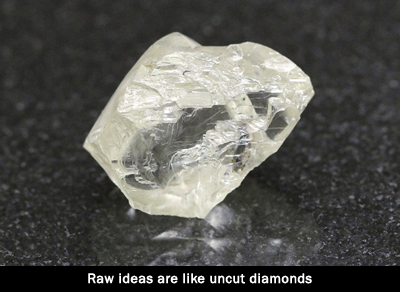So you’ve brainstormed what seems like a great idea.
But you’re not sure what it’s real value is, so you sit on it. You don’t write it down. You just vow to keep it in your mind.
Because it’s been ignored, the idea slowly fades, like the morning fog on a sunny morning. Soon, the last wisps of it are gone, as if it never existed.
Then, a year later, it happens.
 You’re just going about your business and all of the sudden you come face-to-face with something that looks JUST LIKE YOUR IDEA.
You’re just going about your business and all of the sudden you come face-to-face with something that looks JUST LIKE YOUR IDEA.
Someone “stole” YOUR idea and is profiting from it.
HOW COULD THEY?!!
After you calm down, it dawns on you:
Ideas, no matter how brilliant, aren’t worth anything unless you DO something with them.
You didn’t act on your flash of insight. They did.
How? Chances are, they had a process to transform their raw brainstorms into ideas, plans and action. That’s what it takes to profit from your ideas. There are no shortcuts.
Raw ideas: Like diamonds in the rough
 Ideas are like uncut diamonds. They need work to yield their immense value. Gemstones need to be cut and polished by a skilled professional, who knows how to bring forth their natural beauty.
Ideas are like uncut diamonds. They need work to yield their immense value. Gemstones need to be cut and polished by a skilled professional, who knows how to bring forth their natural beauty.
Ideas need improvement, incubation, evaluation and action. Only then will they resemble a priceless diamond.
So how can you transform your raw ideas into the equivalent of diamonds?
You need a process. Many creative experts recommend these five steps:
1. Investigate
Albert Einstein, one of the most brilliant minds who ever lived, was a big fan of focusing much more effort on problem definition, and much less on everyone’s favorite – brainstorming solutions. He famously said: “If I had an hour to solve a problem I’d spend 55 minutes thinking about the problem and 5 minutes thinking about solutions.”
In other words, you need to “deconstruct” your problem or challenge – break it into its elements and determine if you can solve any of these sub-problems. This increases the odds that you will correctly identify the actual underlying problem to solve, rather than picking away unproductively at peripheral symptoms. Often, when you go through this process, the solution becomes immediately evident.
Another way to get started with creative problem solving is to immerse yourself in the topic or challenge at hand. Do Google searches. Talk to subject matter experts. Search for similar problems that have already been solved in other industries, markets or professions, and figure out how you can adapt it to your current creative challenge.
And use a notebook or digital note taking tool to capture and organize all of your research and ideas.
2. Generate
One of the best ways to engage the creative side of your brain is to utilize tools and techniques that help you think in fresh directions. Your brain is a powerful associative tool. By feeding it with creative stimuli, you can get it to respond with ideas and insights that may be of value to you.
Pick up any creative thinking book and you’ll find dozens of creative thinking exercises that can help you break out of your rutted thinking and generate fresh ideas and insights. One book I highly recommend that’s a cornucopia of creativity techniques is Thinkertoys by Michael Michalko. It’s my favorite creative problem solving book!
There are also numerous hand-held and digital ideation tools that can help you jump-start your thinking in new, fresh directions – on demand! Visit my personal website for reviews of them. [LINK]
3. Incubate
One of the ways to end up with really powerful idea is to take a fresh look at the ones you brainstormed to see if there are ways that they can be improved.
SCAMPER is an excellent brainstorming technique for this. It gives you a set of perspectives you can use to view your idea. Often, it can reveal new insights and ideas that weren’t visible before.
Idea combination is another powerful idea improvement strategy. Merged together, the result will probably be a case of 1+1=5. In other words, the consolidated idea should be stronger than either individual idea was on its own.
You may be tempted to skip this step, assuming that once you have brainstormed ideas and selected several for implementation, you’re done. If you do that, you’re missing out on a big opportunity to develop even better solution. Don’t take a shortcut. Invest some time in idea improvement and combination.
4. Evaluate
Ideas only have value if you implement them. That’s why it’s important to have an organized system for evaluating your ideas. Like tags and folders, a well-designed framework for evaluating your ideas will help you add important context to them, see you can easily locate and take action on those that are most important to you.
According to creativity experts, there a number of popular ways to evaluate your ideas. Here are three of the most popular:
- Implementation cost
- Ease of implementation
- Resource requirements
I recommend that you select one or two evaluation frameworks. Don’t make this process too complicated. The next step is to create a scale for scoring your ideas. I recommend a scale of 1-5 or 1-10., where higher scoring ideas have greater value. You can also rank ideas using an ABC method. It all depends how granular you want to get in your assessments.
Once you have evaluation criteria set up, you can use them to assign values to each of your ideas. If you decide to utilize multiple evaluation criteria, simply total the scores of each individual criterion to arrive at a total score.
5. Activate
 By now, you should be left with a short list of really valuable ideas. Now it’s time to implement them. There’s no magic here – just a lot of work and dedication to make your idea a reality. You need a plan. Be sure you’re clear on these elements of it:
By now, you should be left with a short list of really valuable ideas. Now it’s time to implement them. There’s no magic here – just a lot of work and dedication to make your idea a reality. You need a plan. Be sure you’re clear on these elements of it:
Target audience: Who will this idea serve? How will it benefit them, solve a problem for them or make their lives better?
Objections: What objections are you likely to encounter as you promote your new idea? How can you anticipate and sidestep or mitigate them?
Constraints: What constraints do you face? Money? Manpower? Other resources? Who can you partner with to get the resources you need?
Who can help? What allies or colleagues are in your network who can help you to shepherd your new idea to life?
It’s time for you to get serious about your ideas
With this simple, 5 step creative process, you’re now ready to leverage much more value from your ideas.
But only if you decide to put it into practice.
Did you know you can do so within the popular personal information management software Evernote?
This blog post is excerpted from my book, Eureka! How to Use Evernote to Generate, Incubate, Evaluate & Activate Your Best Ideas. Not only do I explain how you can use it to implement this 5-step ideas-to-action process, I also give you templates to help you get started immediately!


